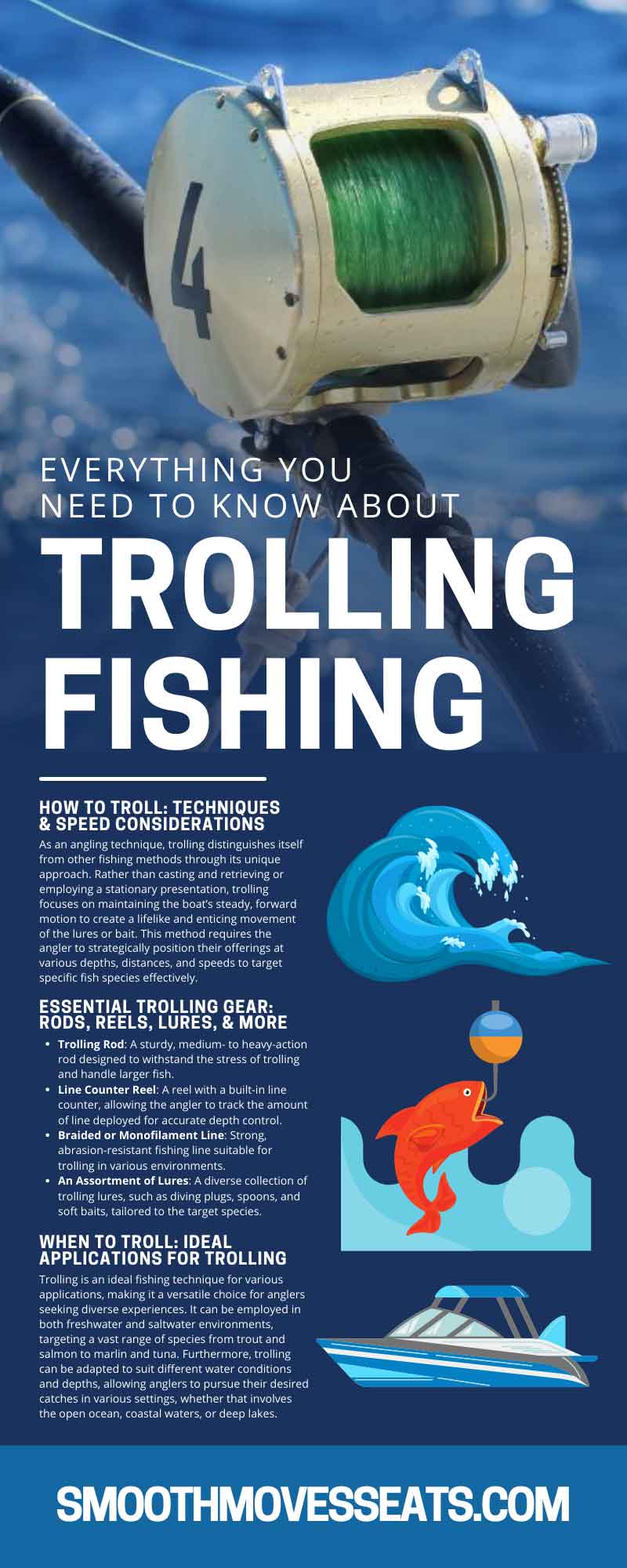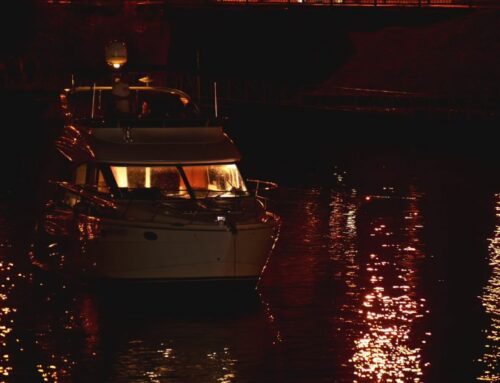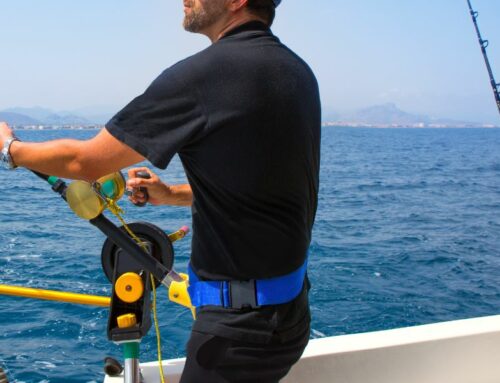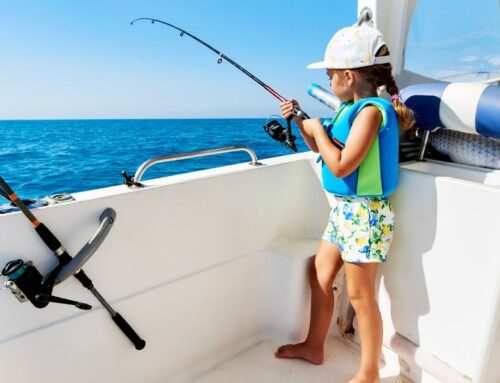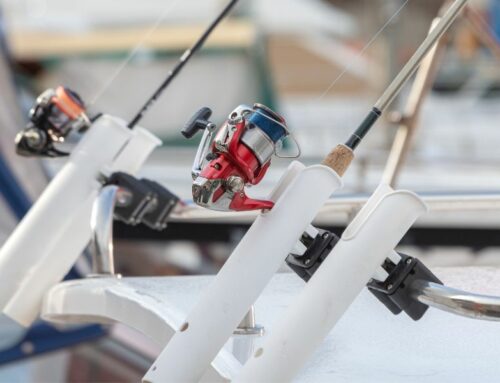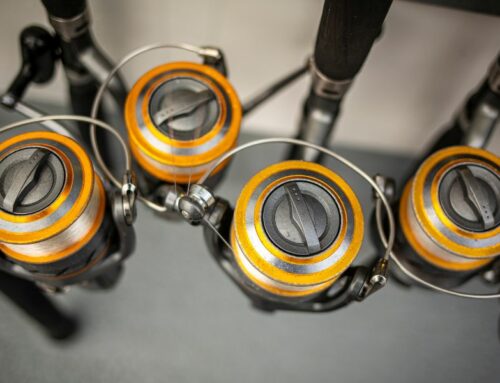Trolling fishing is a time-honored angling technique that has captivated enthusiasts for generations. At its core, trolling involves the artful presentation of lures or bait behind a moving vessel, enticing fish to strike as the mesmerizing action draws them in. With a seamless blend of skill, knowledge, and patience, trolling offers a rewarding and engaging experience for both novice and seasoned fisherpeople alike. To ensure greater success on your next boating excursion, check out our helpful guide containing everything you need to know about trolling fishing.
How To Troll: Techniques & Speed Considerations
As an angling technique, trolling distinguishes itself from other fishing methods through its unique approach. Rather than casting and retrieving or employing a stationary presentation, trolling focuses on maintaining the boat’s steady, forward motion to create a lifelike and enticing movement of the lures or bait. This method requires the angler to strategically position their offerings at various depths, distances, and speeds to target specific fish species effectively.
One specific technique is flatline trolling, where the fishing line is released directly from the rod without additional weight or planing devices. This technique is particularly effective when targeting fish that reside near the surface or in shallow waters. To execute flatline trolling, let out a sufficient length of the line behind the boat, ensuring that the lure or bait remains at an appropriate distance to avoid spooking fish while still providing an enticing presentation.
Another popular trolling technique uses downriggers or planer boards to control the depth at which the lure or bait is presented. Downriggers consist of a weighted cable and release clip, allowing the angler to position their offering at the desired depth accurately. To set up a downrigger, attach the line to the release clip, then lower the weight into the water until it reaches the preferred depth. Planer boards, on the other hand, are designed to spread the lines horizontally, covering a larger area and preventing tangles during multi-line trolling. Simply attach the line to the planer board’s clip and let it out to the side of the boat, adjusting the distance as needed for optimal coverage.
Speed is a critical factor to consider when trolling fishing, as it directly influences the action and effectiveness of the lures or bait being used. Generally, trolling involves maintaining slower, consistent speeds to mimic the natural movement of prey and entice fish to strike. The optimal speed for trolling varies depending on the target species, water conditions, and type of lure being used. However, a general guideline is to maintain a speed between 1.5 and 4.5 miles per hour. To ensure consistent speeds, anglers can utilize trolling motor systems or adjust the throttle on their main engine. Monitoring the lure’s performance at different speeds and adjusting accordingly will help anglers determine the most productive pace for a successful day on the water.
Essential Trolling Gear: Rods, Reels, Lures, & More
The importance of having the right gear when trolling cannot be overstated, as it directly impacts the angler’s ability to effectively target specific fish species and maximize their chances of success. Equipping oneself with high-quality, trolling-specific equipment ensures a more efficient and enjoyable experience on the water. Here are seven items every trolling boat needs to ensure success:
- Trolling Rod: A sturdy, medium- to heavy-action rod designed to withstand the stress of trolling and handle larger fish.
- Line Counter Reel: A reel with a built-in line counter, allowing the angler to track the amount of line deployed for accurate depth control.
- Braided or Monofilament Line: Strong, abrasion-resistant fishing line suitable for trolling in various environments.
- An Assortment of Lures: A diverse collection of trolling lures, such as diving plugs, spoons, and soft baits, tailored to the target species.
- Lead Core Line or Wireline: Specialty lines used for achieving greater depth without the need for additional weights.
- Swivels and Snaps: Hardware components that connect the line to the lure, minimizing line twists and easing the process of changing lures.
- Rod Holders: Sturdy mounts for securing trolling rods, allowing the angler to manage multiple lines and maintain control over their setup.
In addition to these essential trolling gear items, anglers may also consider investing in other equipment that, while not strictly required, can greatly enhance their overall experience. This might include electronic fish finders, GPS devices, and specialized tackle storage solutions, which can contribute to more efficient fishing and a more organized and streamlined time on the water.
When To Troll: Ideal Applications for Trolling
Choosing trolling over other fishing techniques offers many benefits that make it an appealing option for anglers. One of the primary advantages is its ability to cover vast areas of water, increasing the likelihood of locating and targeting specific fish species. This method is particularly effective when trying to locate schooling or migratory fish that may be scattered across large expanses. Additionally, trolling allows for the simultaneous use of multiple lines, further improving the odds of success by presenting various lures and baits at different depths and distances.
Trolling is an ideal fishing technique for various applications, making it a versatile choice for anglers seeking diverse experiences. It can be employed in both freshwater and saltwater environments, targeting a vast range of species from trout and salmon to marlin and tuna. Furthermore, trolling can be adapted to suit different water conditions and depths, allowing anglers to pursue their desired catches in various settings, whether that involves the open ocean, coastal waters, or deep lakes.
Trolling In Comfort: Creating a Calm Onboard Experience
Creating a comfortable onboard environment is crucial for anglers who plan to spend extended periods trolling, as it can significantly impact their stamina and overall enjoyment of the water. By ensuring a comfortable setup, anglers can troll fish for longer durations, increasing their chances of reeling in a massive haul. One upgrade to consider for enhancing comfort is the implementation of advanced boat seat suspension systems. These systems provide improved shock absorption and reduced impact from rough waters, allowing anglers to maintain focus and energy throughout their fishing expeditions. You can find these suspension solutions for your marine vessel here at Smooth Moves!
Now that we’ve covered everything you need to know about trolling fishing, it’s time to put these insights into practice and haul in a massive catch. Contact our friendly team today to learn more about the benefits of upgrading your boat’s existing seating to ensure a longer, more enjoyable experience on the water.



